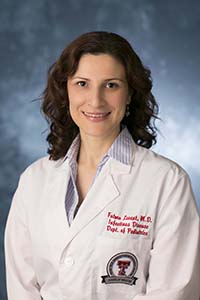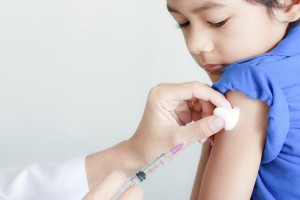Childhood Immunizations and Disease Outbreaks

Childhood vaccinations are the most cost-effective and successful public health interventions. Vaccines have minimized or eliminated some infectious diseases that once injured or killed large numbers of people, such as polio and smallpox.
Scientists, doctors and health care professionals only give vaccines to children after careful review. Vaccines will involve some discomfort and may cause pain, redness and tenderness at the site of injection, but this is minimal compared to the pain, discomfort and injury of the diseases vaccines prevent. Serious side effects, such as severe allergic reaction, are very rare and closely monitored.
Vaccines are not only effective in protecting the vaccinated individuals, but also confer a broader protection for communities called a “herd immunity.” When sufficiently high proportion of a population is vaccinated against communicable diseases, the entire population can be protected. Herd immunity is critical for protecting the health of many groups of people who are especially vulnerable to communicable diseases, including those who cannot be or choose not to get vaccinated for multiple reasons and those who have been vaccinated but whose immunological response is insufficient to protect them.
Because children are especially vulnerable to certain diseases, and vaccines help the body develop disease immunity, many vaccines are most effective when administered to children at a young age according to a recommended immunization schedule. However, a significant number of children in the U.S. do not receive the recommended schedule of vaccinations due to parents’ decision or barriers to access.
Although all states have vaccination mandates for schoolchildren, in recent years they have granted a growing number of nonmedical exemptions. As a result, the risk of infectious disease outbreaks, especially among children, has increased. This rise in nonmedical exemptions has contributed to recent outbreaks and increased rates of vaccine-preventable diseases, such as measles and pertussis (whooping cough).
Measles cases increased significantly after the year 2000, which was the result of
greater viral transmission after importation into the U. S., according to the Centers
for Disease Control and Prevention (CDC). In 2014, the U.S. experienced a record number
of measles cases, with 668 cases from 27 states, since the elimination was documented
in 2000. Most of these cases were part of a large multi-state outbreak linked to an
amusement park in California. The majority of people who got measles were unvaccinated.

Measles spreads easily, and can cause pneumonia, encephalitis (swelling of the brain) and even death. Young children are at the highest risk for serious complications from measles. Measles is still common in many parts of the world including countries in Europe, Asia, the Pacific and Africa. Travelers with measles continue to bring disease to the United States. Measles can spread when it reaches a community where groups of people are unvaccinated.
Pertussis cases were reported to rise in many states after 2012. The incidence rate of pertussis among infants exceeded that of all other age groups. Rates also increased in children seven through 10 years and adolescents 13 and 14 years of age. Whooping cough can be deadly, especially for young babies. From 2000 to 2014, there were 277 deaths reported from whooping cough in the U.S. Most of the deaths were in babies younger than three months of age, who are too young to be fully protected against whooping cough through vaccines.
Some of this resurgence may be attributed to other factors, such as the “acellular” pertussis vaccine’s diminished long-term effectiveness. However, there is a substantial research showing that the growth of the nonmedical exemptions has contributed to an increase of the overall increase of pertussis.
Vaccinating your children according to the recommended schedule is designed to protect them from serious infections when they are most vulnerable and before they are exposed to potentially life-threatening diseases. A child should never have to suffer through and possibly die from a vaccine-preventable disease in this century. It is important that we continue to fully immunize our children, which will not only protect our families, but also will help to prevent the spread of these diseases in the community.
Fatma Levent, M.D., is an infectious disease pediatrician at Texas Tech Physicians — Pediatrics and an associate professor at the Texas Tech University Health Sciences Center School of Medicine
Related Stories
How Does Your Garden Grow?
As spring approaches, some people’s thoughts turn to gardening. Whether it’s a flower garden they desire or a vegetable garden want to have, they begin planning what they’ll plant and what they need to do to ensure a successful garden.
Adopt a Growth Mindset for a Better Life
A “growth mindset” accepts that our intelligence and talents can develop over time, and a person with that mindset understands that intelligence and talents can improve through effort and learning.
Drug Use, Family History Can Lead to Heart Disease in Younger Adults
Abstaining from drug abuse and an early diagnosis of familial hypercholesterolemia (high cholesterol) can help prevent heart disease.
Recent Stories
TTUHSC, TTU School of Veterinary Medicine Recognize Student Research During Inaugural Amarillo Research Symposium
More than 100 student and trainee researchers from the TTUHSC and the TTU School of Veterinary Medicine presented research findings at the 2024 Student Research Day on April 19.
The TTUHSC Laura W. Bush Institute for Women’s Health Welcomes Ben Carson as Power of the Purse Keynote Speaker
Retired neurosurgeon and former U.S. Secretary of Housing and Urban Development Ben Carson, M.D., delivered a keynote address at the Power of the Purse luncheon and fundraiser today (April 18).
Filling the Gap: PA Impact on Rural Health Care
Assistant Professor and Director of Clinical Education Elesea Villegas, MPAS, PA-C, spoke about the challenges rural health care currently faces and how PAs are stepping up to better serve the rural patient population.
